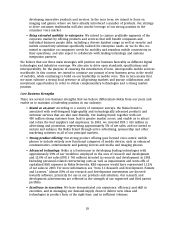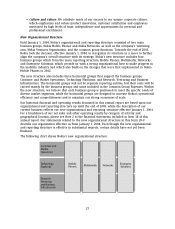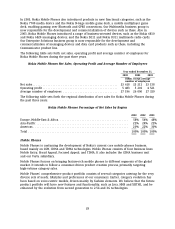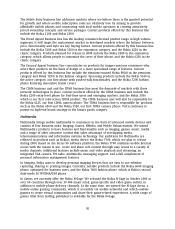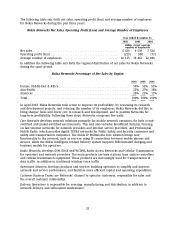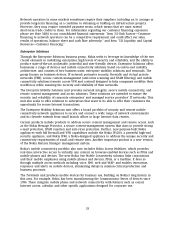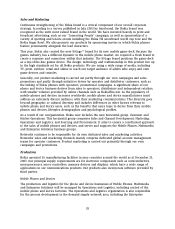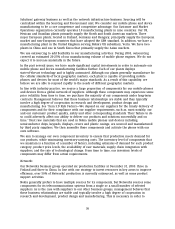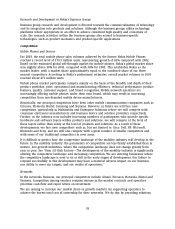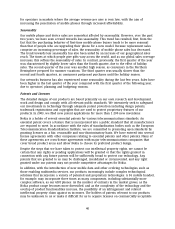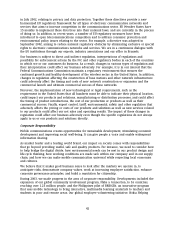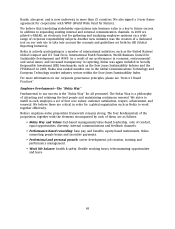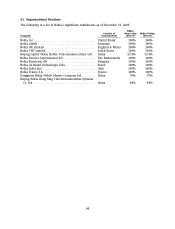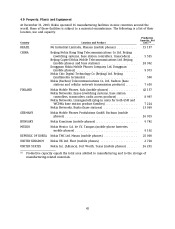Nokia 2003 Annual Report Download - page 37
Download and view the complete annual report
Please find page 37 of the 2003 Nokia annual report below. You can navigate through the pages in the report by either clicking on the pages listed below, or by using the keyword search tool below to find specific information within the annual report.Solutions’ gateway business as well as the network infrastructure business. Sourcing will be
centralized within the Sourcing and Procurement unit. We consider our mobile phone and device
manufacturing to be a core competence and competitive advantage. Our Customer and Market
Operations organization currently operates 10 manufacturing plants in nine countries. Our US,
Mexican and Brazilian plants primarily supply the North and South American markets. Three
major European plants, located in Finland, Germany and Hungary, principally supply the European
market and non-European countries that have adopted the GSM standard. In addition, we have a
manufacturing plant in the United Kingdom serving Nokia’s UK subsidiary, Vertu. We have two
plants in China and one in South Korea that primarily supply the Asian markets.
We use outsourcing to add flexibility to our manufacturing activities. During 2003, outsourcing
covered an estimated 20-25% of our manufacturing volume of mobile phone engines. We do not
expect it to increase materially in the future.
In the past several years, we have made significant capital investments in order to automate our
mobile phone and device manufacturing facilities further. Each of our plants deploys
state-of-the-art technology and is highly automated. Although our plants generally manufacture for
the cellular standards of local geographic markets, each plant is capable of providing mobile
phones and devices for most of the world’s major standards. As a result of this capability, we
believe we are able to respond rapidly to the needs of different geographic markets.
In line with industry practice, we source a large proportion of components for our mobile phones
and devices from a global network of suppliers. Although these components may experience some
price volatility from time to time, we purchase the majority of our components under long-term
contracts. Management believes that these business relationships are stable and they typically
involve a high degree of cooperation in research and development, product design and
manufacturing. See ‘‘Item 3.D Risk Factors—We depend on our suppliers for the timely delivery of
components and for their compliance with our supplier requirements, such as, most notably, our
and our customers’ product quality, safety and other corresponding standards. Their failure to do
so could adversely affect our ability to deliver our products and solutions successfully and on
time.’’ Most raw materials that are used in Nokia mobile phones and devices including
semiconductor chips, keypads, displays, covers and plastic casings, are sourced and manufactured
by third party suppliers. We then assemble these components and activate the phone with our
own software.
We aim to manage our own component inventory to ensure that production meets demand for
our products, while minimizing inventory-carrying costs. The inventory level of components that
we maintain is a function of a number of factors, including estimates of demand for each product
category, product price levels, the availability of raw materials, supply chain integration with
suppliers, and the rate of technological change. From time to time, our inventory levels of
components may differ from actual requirements.
Networks
Our Networks business group operated six production facilities at December 31, 2003: three in
Finland and three in China. In line with our strategy to invest resources in key areas to improve
efficiency, over 50% of Networks’ production is currently outsourced, as well as some product
support activities.
Nokia generally prefers to have multiple sources for its components, but Networks sources some
components for its telecommunications systems from a single or a small number of selected
suppliers. As is the case with suppliers to our other business groups, management believes that
these business relationships are stable and typically involve a high degree of cooperation in
research and development, product design and manufacturing. This is necessary in order to
36


